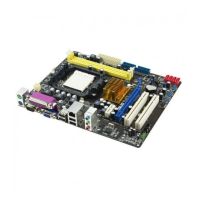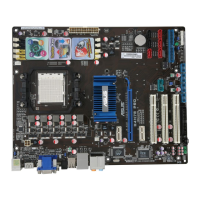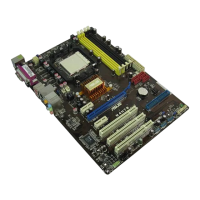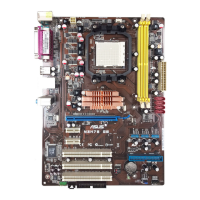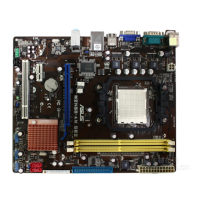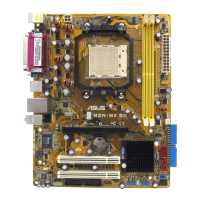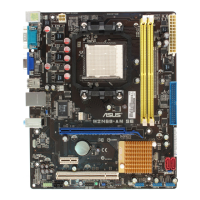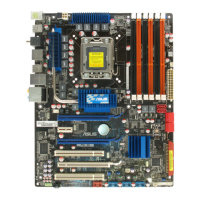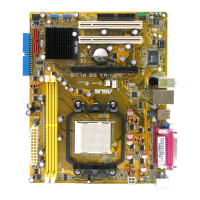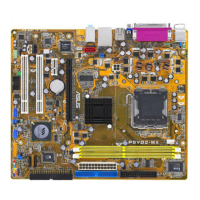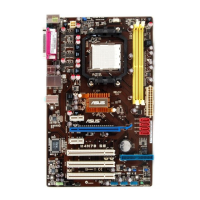
Do you have a question about the Asus M4N78 SE and is the answer not in the manual?
| CPU Socket | AM2+ |
|---|---|
| Memory Type | DDR2 |
| Memory Slots | 4 x DIMM |
| Max Memory | 16 GB |
| Form Factor | ATX |
| S/PDIF Out | 1 x Optical |
| Expansion Slots | 1 x PCIe x16, 2 x PCIe x1, 3 x PCI |
| USB Ports | 12 x USB 2.0 |
| LAN | Realtek RTL8211CL Gigabit LAN controller |
| Video Outputs | VGA |
| Dimensions | 30.5 cm x 24.4 cm |
| Power Pin | 24-pin ATX |
| Storage Interfaces | 1 x UltraDMA 133/100/66 6 x SATA 3 Gb/s |
| PS/2 | 1 x PS/2 keyboard/mouse combo port |
Details FCC compliance requirements and conditions for digital devices.
Outlines Canadian compliance limits for radio noise emissions from digital apparatus.
Precautions to prevent electrical shock hazard during system operation and component handling.
Precautions for safe installation and operation of the motherboard and its components.
Outlines the structure and content of the user guide, detailing chapter contents.
Explains symbols used for safety, warnings, and important instructions in the manual.
Defines text formatting conventions like bold, italics, and key notation used in the manual.
Directs users to ASUS websites for updated product and software information.
Details supported AMD processors, socket type, and CPU features like Cool 'n' Quiet.
Specifies the NVIDIA nForce 720D chipset and its HyperTransport interface speeds.
Details dual-channel DDR2 architecture, DIMM slots, and maximum supported memory.
Lists available PCI Express and PCI slots on the motherboard.
Outlines UltraDMA, Serial ATA connectors, and NVIDIA MediaShield RAID support.
Describes the ALC662 High Definition Audio CODEC and USB port availability.
Details the integrated Gigabit MAC and external Realtek PHY.
Lists ASUS proprietary features like Quiet Thermal Solution, Q-Fan, EZ DIY, EPU, etc.
Details the PS/2 keyboard, RJ45, USB, Audio, LPT, and COM ports on the rear panel.
Lists internal connectors like ATX power, CPU fan, SATA, system panel, etc.
Lists included accessories like SATA cable, I/O shield, and specifies the ATX form factor.
Lists the contents of the support DVD, including drivers, utilities, and software.
Welcomes the user and introduces the motherboard's features and technologies.
Lists the items included in the motherboard package.
Details key product features like AMD CPU support and DDR2 memory.
Explains the features of the NVIDIA nForce 720D chipset, including HyperTransport and PCIe support.
Details the benefits of HyperTransport 3.0 technology and AMD CPU features.
Highlights native DDR2 1066 support, Gigabit LAN, and High Definition Audio.
Explains the benefits of PCI Express 2.0 and support for SATA 3Gb/s drives.
Explains the AI NET2 feature for cable detection and HD Audio CODEC.
Highlights RoHS compliance and custom boot logo personalization.
Details ASUS CrashFree BIOS 3 and ASUS EZ Flash 2 for BIOS recovery and updates.
Describes ASUS Express Gate for instant access and ASUS EPU for power management.
Explains the C.P.R. feature for automatic CPU setting restoration after overclocking failure.
Advises on handling precautions, grounding, and power disconnection before installation.
Explains the function of the standby power LED and its indication of system status.
Guides on orienting the motherboard correctly within the chassis.
Identifies the screw hole locations for securing the motherboard and warns against overtightening.
Provides a visual diagram of the motherboard with numbered components.
Lists and describes the function of each numbered connector, jumper, and slot on the layout.
Provides step-by-step instructions for installing the CPU into the socket.
Covers securing the CPU with the socket lever and connecting the CPU fan cable.
Guides on properly attaching the CPU heatsink and fan assembly to the retention module.
Introduces the DDR2 DIMM sockets and their channel configuration (A and B).
Explains memory installation rules, dual-channel mapping, and OS limitations for memory.
Lists qualified vendors and part numbers for DDR2-667MHz memory modules.
Continues the list of qualified vendors and part numbers for DDR2-667MHz memory.
Lists qualified vendors and part numbers for DDR2-800MHz memory modules.
Continues the list of qualified vendors and part numbers for DDR2-800MHz memory.
Lists qualified vendors and part numbers for DDR2-1066MHz memory modules.
Provides step-by-step instructions for installing a DDR2 DIMM into the socket.
Details the procedure for safely removing a DIMM from the socket.
Guides on the physical installation process of an expansion card.
Explains the software configuration steps after installing an expansion card.
Describes the types of cards supported by PCI and PCI Express slots.
Explains the CLRTC jumper for clearing CMOS settings and BIOS passwords.
Configures the keyboard wake-up feature and its requirements.
Controls USB wake-up functionality from different sleep states.
Identifies and describes the PS/2, Parallel, LAN, Line In, Line Out, and Mic ports.
Details the USB 2.0 ports and COM port on the rear panel for device connectivity.
Explains the 24-pin EATXPWR and 4-pin ATX12V connectors for power supply.
Details the 40-pin IDE connector for Ultra DMA cables and device configuration.
Describes the 4-pin connector for an additional S/PDIF digital audio port.
Details the 7-pin SATA connectors for hard drives and optical drives.
Describes the 4-pin connector for receiving audio input from CD-ROMs.
Details connectors for power/reset buttons, LEDs, and HDD activity.
Describes the 4-pin connector for the system warning speaker.
Details internal USB 2.0 connectors for front panel USB modules.
Describes the connector for front panel HD Audio or AC'97 audio modules.
Provides guidance on installing OS and necessary service packs.
Explains the contents of the support DVD and how to run it.
Introduces BIOS management and updating procedures.
Details the ASUS Update utility for managing and updating the motherboard BIOS.
Explains how to update BIOS using a saved BIOS file.
Describes the EZ Flash 2 utility for BIOS updates via USB.
Explains the BIOS recovery tool for restoring corrupted BIOS files.
Introduces the BIOS Setup utility for configuring system settings.
Identifies key elements like menu items, configuration fields, and navigation keys.
Explains how to navigate through the main menu items (Main, Advanced, Power, etc.).
Explains the function of various keys used for navigation within the BIOS setup.
Describes how menu items and sub-menu items are displayed and accessed.
Explains how to view and change configuration field values and use pop-up windows.
Provides an overview of the Main menu screen and its basic system information.
Explains how to set the system time and date within the BIOS.
Details how BIOS detects and displays IDE/SATA device information.
Explains settings like LBA, Block Transfer, PIO, DMA, SMART, and 32Bit Data Transfer.
Details settings for onboard PCI IDE and SATA controllers.
Describes how the BIOS displays auto-detected BIOS, CPU, and system memory information.
Introduces the Advanced menu for CPU and system device settings.
Covers CPU overclocking settings and profiles.
Details settings for CPU frequency, overclocking options, and profiles.
Explains settings for PCIE overclocking and frequency adjustment.
Covers processor multiplier, CPU over voltage, and VDDNB over voltage settings.
Details HyperTransport speed/width and memory clock mode/value settings.
Explains various DRAM timing parameters like CAS Latency, TRCD, TRP, etc.
Details settings for memory over voltage and chipset voltage.
Lists CPU-related settings like GART Error Reporting, Microcode Updation, and Cool 'n' Quiet.
Introduces chipset settings and NorthBridge configuration options.
Details memory interleaving and clock settings for DIMMs.
Covers DCT Unganged Mode, DDR power down, ECC, graphics adapter priority, and LAN settings.
Lists settings for Serial, Parallel ports and their modes.
Covers PCI/PnP device settings, IRQ, DMA, and Plug and Play OS configuration.
Details settings for USB functions, controllers, legacy support, and modes.
Introduces the Power menu for ACPI and APM configuration.
Explains Suspend Mode, ACPI 2.0, and APIC support options.
Details settings for AC power loss recovery and power-on by PCI/PCIE devices.
Covers wake-up settings via Ring, PS/2 devices, and RTC Alarm.
Details monitoring of CPU/MB temperatures, fan speeds, and voltages.
Explains the ASUS Q-Fan feature for intelligent fan speed control.
Introduces the Boot menu for configuring system boot options.
Sets the sequence for bootable devices.
Configures options like Quick Boot, Full Screen Logo, and Bootup Num-Lock.
Configures BIOS behavior for errors and DEL key prompt display.
Details settings for supervisor password and user access levels.
Explains how to set, change, or clear user passwords in BIOS.
Configures when BIOS checks for user password.
Introduces the Tools menu for utilities like ASUS EZ Flash 2.
Allows running the ASUS EZ Flash 2 utility for BIOS updates.
Configures Express Gate feature, timer, and user data reset.
Enables or disables checking the Realtek Phy LAN cable during POST.
Introduces the Exit menu for saving/discarding changes and loading defaults.
Explains how to save or discard BIOS changes before exiting.
Describes how to load the default BIOS settings.
